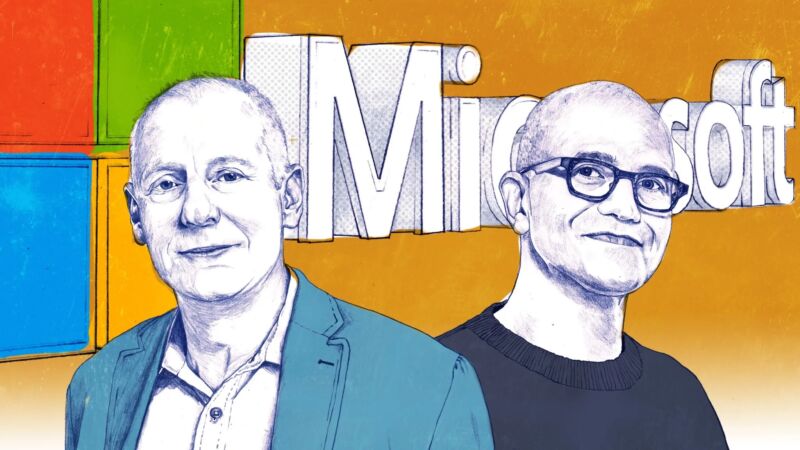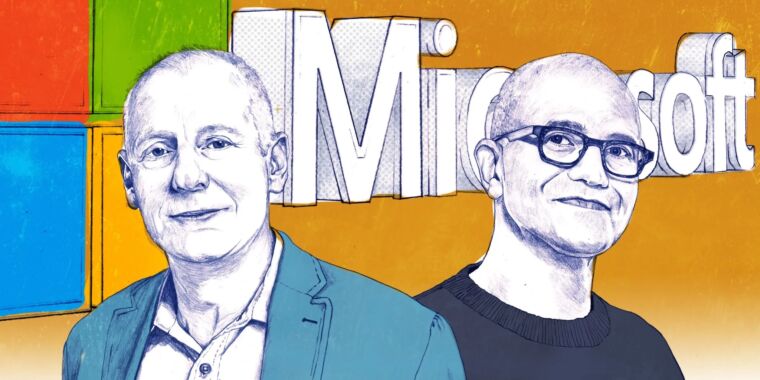Satya Nadella: Microsoft has “permission to build the next Internet”
[ad_1]

Financial Times
Not long after being promoted to the role of chief executive at Microsoft, in 2014, Satya Nadella had faced calls to ditch the tech group’s Xbox games division and concentrate its resources on cloud computing—to compete with rivals, such as Amazon. But instead, Nadella saw an opportunity to build new customer bases through online gaming communities. His first deal as chief executive was buying Minecraft, the three-dimensional world-building game.
At the same time, he further developed Microsoft’s dominant position in personal and business software and expanded its cloud and server offerings. Shares in the group have risen eightfold under Nadella’s tenure, and it remains the world’s largest software group.
However, last month’s $75 billion deal to buy video game maker Activision Blizzard will also make Microsoft the world’s third-biggest gaming company by revenue, behind only China’s Tencent and Japan’s Sony.
Not only does it extend Microsoft’s vertical integration in gaming, giving it yet more content for its Xbox console and PC games distribution systems, it also shows how Nadella sees the future of online interactions—at work, in education, and in the home. He indicated that the Activision purchase would also power the company’s move into the metaverse—the immersive, virtual, interactive worlds the Big Tech companies are racing to build.
Here, in his first interview since the deal was announced, Nadella tells the FT’s West Coast editor, Richard Waters, how gaming will shape the next computing platform.
Richard Waters: When you came in, most of Microsoft’s business was in business technology, helping millions of workers do their jobs. And in the years you’ve been there, the company’s been through this amazing change with the move to the cloud. Now, you’re buying a big gaming company, and I guess people are wondering, does this fit together? Is it all part of one story?
Satya Nadella: [In] the Microsoft I grew up in, I always think about three things—and we added a fourth. The three things that we always had are: we built tools for people to write software; we built tools for people to drive their personal and organizational productivity; and we built games. That’s the three things that Microsoft has done from time immemorial. The first game, I think, was built before Windows was there. existed on DOS. And so, to me, gaming, coding, productivity, or knowledge worker tools are at the core.
The thing that we added pretty successfully—that most people thought we would never be able to do—is become an enterprise company… actually really build enterprise infrastructure… and business applications. And guess what? We now do that as well.
I feel those are the new things that we have added, whereas [the other] three things have been there all my life… And gaming, interestingly enough, is more integrated.
Even when Xbox came out 20 years ago, it was sort of a thing on the side, whereas now… the future of gaming is [subscription service] Game Pass and xCloud and the console, of course, [and] a PC. One of my coolest features is I can play the game instantly because I don’t even need to wait for it to download. I can just start playing on the cloud and then have it slowly stream down and use the local CPU.
So, to me… it’s much more integrated than, “oh, it’s a side bet.”
RW: How does helping people play games link to the relationships with your customers and communities that you’re building? How are you helping them live their lives?
SN: Take what’s happening with the metaverse. What is the metaverse? Metaverse is essentially about creating games. It is about being able to put people, places, things [in] a physics engine and then having all the people, places, things in the physics engine relate to each other.
You and I will be sitting on a conference room table soon with either our avatars or our holograms or even 2D surfaces with surround audio. Guess what? The place where we have been doing that forever… is gaming.
And so, the way we will even approach the system side of what we’re going to build for the metaverse is, essentially, democratize the game building… and bring it to anybody who wants to build any space and have essentially, people, places, [and] things digitized and relating to each other with their body presence.
RW: But the people who are playing those games, at the moment they’re playing first-person shooter games… It’s pretty clear why they’re getting into them and it has nothing to do with metaverse—it’s simply that they want a bit of fun. What do you see in the future? What are people going to be doing inside this intellectual property that Microsoft is paying so much for?
SN: First of all, if you think about it, the genres we’re in are much broader than first-person shooter. I mean, we love Flight Simulator. We love Minecraft. We love first-person shooters or [car-racing game] Forza. Think about how we’re able to tell even the story of car racing through a cultural lens. This entire new game that we produced [Forza Horizon 5] is all about Mexico, and the Mexican setting and car racing… You think “my avatar in Forza is my car” and how I decorate it.
To me, just being great at game building gives us the permission to build this next platform, which is essentially the next Internet: the embodied presence. Today, I play a game, but I’m not in the game. Now, we can start dreaming [that] through these metaverses: I can literally be in the game, just like I can be in a conference room with you in a meeting. That metaphor and the technology… will manifest itself in different contexts.
Another one would be in the context of a very different business process. If you look at retail or construction, that’s also like when you create a digital twin: you have a factory and you are trying to visualize how to simulate its operation. That’s also a game-playing exercise, except you’re not game playing. You’re trying to simulate how a factory functions.
[ad_2]
Source link




